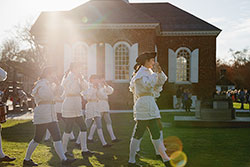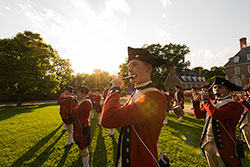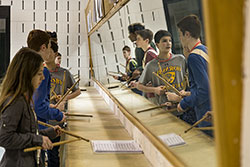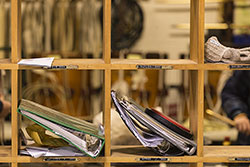Page content
Sphere of Influence
Fifes and Drums: More than Marching and Music
by Ben Swenson
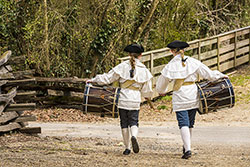
All members of the Fifes and Drums, including these members of the Junior Corps, participate in countless hours of practice.
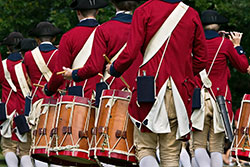
Audiences at performances see only straight lines, smart marching and authentic uniforms and instruments.
Fife and drum corps pride themselves on uniformity and precision. But that doesn't mean performances can't have some surprises, said Henry Gaston, fife section leader with the Colonial Williamsburg Fifes and Drums.
In 2016, for instance, the Fifes and Drums joined the Jordanian Armed Forces Bagpipe Band at the Virginia International Tattoo in Norfolk, Va., to play a moving rendition of Yankee Doodle. And then there was a "drum off" — a sort of musical duel — between Colonial Williamsburg's contingent and the Top Secret Drum Corps of Basel, Switzerland, considered by many to be the world's premier drum ensemble.
"We like to think we won that one," said Gaston, adding with a grin, "At least we had the hometown crowd."
Of course, memorable performances are no accident. The iconic ensemble is often the public face of The Colonial Williamsburg Foundation, and the corps is built on not only musicianship but also discipline and history. In the 18th century, military music was used to communicate orders, sound alarms and call troops to assemble and disperse. And it was played by children and teenagers, generally between the ages of 10 and 18, roughly the same age as those in Colonial Williamsburg's Fifes and Drums.
Since the corps' founding in 1958, it has performed in a variety of settings, from the daily summer marches in the Historic Area to patriotic ceremonies, even the Macy's Thanksgiving Day Parade. The corps has welcomed visiting dignitaries — President Ronald Reagan and Queen Elizabeth II among them.
This largely self-sufficient group is composed entirely of adolescents who mostly lead themselves. The corps has a repertoire of 50 to 60 tunes each year and members learn more than 300 before their tenures are complete. Musicians enter the corps at about age 11 and rise through the ranks until their high school graduation. "This is peer-led and peer-directed," said Larissa Sasgen, a member of the Foundation's Education, Research and Historical Interpretation Division and one of two adult supervisors. "The older musicians work with the younger ones and guide them through the challenges."
This sort of cooperative, merit-based system offers a unique lesson about the value of hard work, Sasgen said. Members of the Fifes and Drums are paid for performances, and for most of them, these positions are their first job. Sasgen said the structure also instills critical lessons of responsibility and communication skills — even how to remain cordial with colleagues of all types and temperaments.
Before even picking up a fife, Gaston knew how arduous the process was because he watched his older brother advance through the corps, earn his ranks and win the respect of those he was charged with directing. Gaston called the experience a genuine confidence builder. "Parents have thanked me for working with their kids, but I tell them that I should be the one thanking them," he said.
Now 18, Gaston said he hopes what he learned in his time with the Fifes and Drums will help prepare him for the next chapters of his life. In August, he will enroll at Virginia Military Institute. He hopes to earn a commission in the U.S. Coast Guard to work in that service's branch of law enforcement.
Clare Provoncha, a rising senior, also wants to pursue a career in the armed forces, possibly by way of a military academy. A drummer and first sergeant, the 17-year-old credits the corps with teaching lessons — especially about working with others — that might have been difficult for children and teens to get elsewhere. "These are skills that other people might spend 10 years or more learning after high school," she said.
Provoncha said there was value beyond developing discipline. "As much as I value the skills we learn, the strong relationships we're cultivating with each other offer a lot of support," she said.
Will Houghland, also a rising senior, said the friendships that members create in the corps often turn into lifelong bonds. Sometimes it's a family bond and his family is living proof. His older sister, his father, even an uncle and a cousin have been members of the Fifes and Drums.
Houghland, a 17-year-old fifer and sergeant, said it's worth the practice hours spent perfecting music and marching in time to be part of this tradition. When the group performs, he said, "we meet people who have heard us before but are surprised to realize that we are not adults."
Oddly enough, emerging technology will be one key to remaining among the premier 18th-century fife and drum corps, according to Sasgen. She said the Fifes and Drums currently relies on paper copies of music and other records, which has worked well enough over the years. But leaders can see a future in which digitization would make instruction and day-to-day operations much easier. "If we are able to bring up music and individuals' achievements on a tablet at the drop of a hat, that would be so much more efficient than the system we have now," she said.
Travel is also at the heart of the corps' education. The chance to perform at distant ceremonies and participate in fife and drum gatherings, called musters, allows the group to connect with and learn from similar corps, many of which are in New England, according to Stewart Pittman, the corps' second adult leader and superviser of the drummers. "We're kind of isolated here in southern Virginia," he said. "These trips connect us to the larger fife and drum community."
Sasgen and Pittman would also like to bolster the instruction by offering "master classes" to the corps' leaders, bringing in experts to offer guidance.
Ben Swenson is a freelance writer living in Williamsburg, Va.
In addition to funds for travel and education, the Fifes and Drums hopes to replace the maces used to direct the movement and music of the corps' performances. To learn more about how you can help with these and other needs, please call 888-CWF-1776 or email [email protected]

